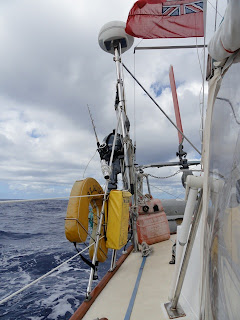We said good bye to Callisto (Who are heading to Samoa) and bucked ourselves up to head west to Tonga. It would be a two night trip and we looked forward to a more lively island that would have plenty of spares and stores.
I kinda like the longer passages because a set routine is the order of the day. Dinner is usually between 1800 and 1900, as is the sunset. We had a bunch of passage meals already cooked and frozen so dinner was merely heating up the main dish and maybe some rice or potatoes to go with it. My only complaint was that the plates are so full of food! Seriously, no one goes hungry on Beaujolais. No way.
So, dinner comes and I take the watch while the cooking is done, then after dinner I generally take the first three hour watch.
Watch means keeping a lookout for any other vessels and to ensure safety of our boat. I make adjustments to the sails or to the Hydrovane when needed. Mostly just sit as comfortably as possible on three cushions (the benches are hard!) and drink water while watching the sea go by.
2200, I wake up the skipper who has a cup of tea and sometimes reads a book. But mostly he is up and about trying to trim and adjust sails to get best performance. I hit the rack and am immediately to sleep.
0100, I am back at it. Comes out to two watches in the middle of the night, but the time passes fairly quickly, especially time spent asleep.
By the way, when we are in the watch mode, we wear flotation and are tethered to the boat via a d-ring and length of nylon strap. We do not leave the cockpit unless all hands are up and present. Our float collars are manually activated co2 inflated horse collars. We have a Raymarine alarm device on our harnesses that will set off the alarm and automatically mark the man overboard position on the chart plotter if we get over thirty feet away from the cockpit.
Smart.
I also carry an Electronic Position Indicating Radio Beacon (EPIRB) that will notify by satellite the Search And Rescue Authorities in Russia and the United States. This beacon will give my GPS position and my name with emergency contact information. This thing cost about $400.00 but it gives peace of mind. The modern EPIRB's have very low rates of false alarms and more importantly, gives rescuers a very accurate picture of your location.
So I have all that going for me. All this safety gear will probably never be used and since I do have it, I will continue to enjoy boring passages. Boring is good.
One notable thing that happened was at 0305, I noticed a couple of lights on the horizon. These were the first lights I had seen on this whole journey!
I stared hard, but it was tough to see even with binoculars, sometimes there and not. This was something to report when the next watch changed at 0400. We continued to catch up with and pass the lights over the next four hours. The light was a catamaran and I took some pics of her the next day.
Back to Tonga!
 |
| Niue in our rear view. |
 |
| Tone meant "Tonga East" 225 NM away |
 |
| Deploy the fish killing stick! |
 |
| Obligatory rainbow pics |
 |
| That catamaran I mentioned earlier |
 |
| The skipper of this cat was singlehanding and was lonely, so he called us a few times to chat on the vhf. |
 |
| LAND HO!!! |
 |
| No time to be jubilant, keep a close eye on our chart to avoid reefs! |
 |
| Morning approaching |
 |
| Tonga Group |
 |
| Note the unseen reef about a quarter mile to our starboard |
 |
| Heading towards the slot which brings us to Vava'u harbor |
 |
| Vava'u is in a fjord type harbor, deep right to the edges, a natural hurricane hole |
 |
| Moored. Moorings cost about $15.00 Tongan a day |
 |
| Stanley visits the Aquarium Cafe |










2 comments:
Stanley is a VERY well-traveled bear. ;-)
I love pictures of moorings with all the sailboats sitting in such beautiful areas! So peaceful! Glad to hear that ya'll practice safety ... better safe than sorry!
Post a Comment